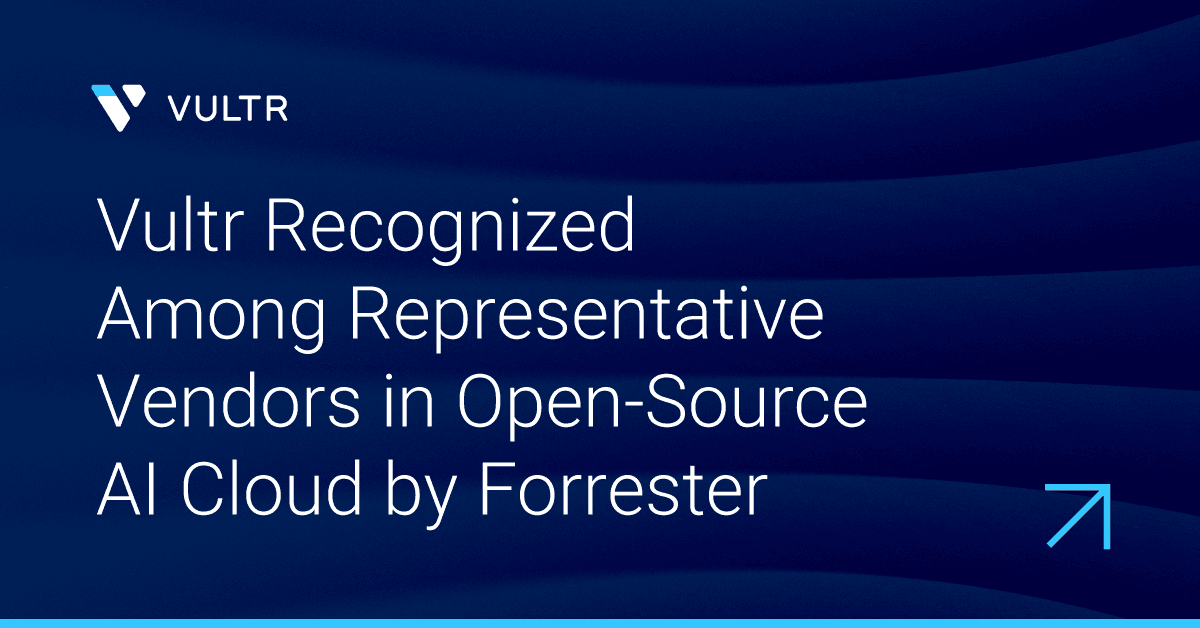The AI era is rewriting the rules of enterprise technology. From real-time decision-making to autonomous operations, AI workloads aren’t just bigger and faster — they’re fundamentally different. Yet many organizations still rely on cloud strategies built for a pre-AI world, where priorities didn’t go far beyond just compute and storage.
This mismatch is a structural problem that can stall AI initiatives, inflate costs, and compromise compliance. Closing that gap requires a new foundation: the AI-native cloud. Forrester’s 2025 report, “How To Get Started With AI-Native Cloud,” examines how forward-thinking enterprises are taking proactive steps toward aligning their infrastructure with AI demands. It also identifies the vendors enabling this transformation, including Vultr among representative vendors in the open-source AI ecosystem.
When legacy cloud hits the AI wall
Picture this: A financial services data science team needs to deploy a new fraud detection model that requires real-time inference on streaming transaction data. Their existing cloud setup, designed for batch processing and steady workloads, can't provision GPU resources fast enough. When they finally get the compute power, latency within the rigid network architecture makes real-time detection impossible. Meanwhile, their compliance team discovers that the model's data residency requirements conflict with their standardized multi-region deployment strategy.
Similar scenarios play out across industries because legacy clouds were optimized for a different era. Traditional architectures relied on monolithic deployments with static scaling, proprietary managed services to reduce operational overhead, and standardized platforms designed for stability over flexibility. Cost models assumed steady-state usage with predictable, long-term commitments.
These approaches delivered reliability and efficiency for their time, but they create fundamental friction with AI's dynamic requirements. Static performance models can't match AI's needs for rapid provisioning and elastic scaling. Standardization becomes a constraint when AI teams need diverse models, frameworks, and specialized compute types. Pricing structures built for consistent usage become unsustainable under AI's variable, compute-intensive demands.
The business impact is immediate and costly
These architectural gaps surface as real business constraints that can derail competitive advantages. Network latency or inflexible data residency rules slow algorithmic trading systems and hinder real-time fraud detection in finance. Healthcare organizations find that cloud setups unable to meet stringent privacy and audit standards delay AI-enabled diagnostics. Manufacturing companies discover that infrastructure that can't scale quickly limits predictive maintenance systems during critical demand spikes.
The report emphasizes that organizations moving ahead successfully are building AI-native strategies intentionally — designing infrastructure, governance, and skills around AI workloads from the start, rather than attempting to retrofit legacy environments.
As Forrester puts it: "Start with strategy. An AI-native cloud can't just be turned on and turned up; it must be composed through a mix of prebuilt or semifinished platform elements that interact with the appropriate data to create new capabilities."
The AI-native alternative: Built for what's coming next
An AI-native cloud is purpose-built for the demands of AI workloads. In the report, Forrester describes five essential considerations that distinguish AI-native infrastructure from legacy cloud approaches.
Architecture matters most. Design modular, composable infrastructure so components can be assembled, scaled, or replaced without disrupting other systems. This allows data science teams to experiment with new frameworks while production workloads remain stable, and enables different business units to customize their AI stack without enterprise-wide migrations.
Deployment flexibility drives results. Use a mix of public, private, and hybrid options to run workloads where they perform best, with flexibility to adjust as requirements evolve. This means sensitive healthcare AI models can remain on-prem while development work leverages public cloud resources.
Ecosystem integration maximizes adaptability. Leverage open-source and Kubernetes-native tools, along with diverse silicon options, to maximize adaptability and minimize vendor lock-in. Organizations can tap into rapid open-source AI innovation while maintaining enterprise-grade operations.
Operations and governance can't be afterthoughts. Bake in security, compliance, and FinOps from the start to enable sustainable, well-governed scaling. This prevents the common scenario where AI projects succeed technically but fail operationally due to unforeseen costs or compliance gaps.
People and skills development accelerates everything else. Build team capability through targeted training and hands-on experience to accelerate responsible AI adoption. Without skilled teams who understand both AI and cloud-native operations, even the best infrastructure sits underutilized.
The report identifies five distinct paths organizations are taking toward AI-native cloud, from open-source ecosystems that maximize flexibility to specialized AI infrastructure platforms that optimize for performance. The key insight: Successful organizations choose their path deliberately based on their specific AI maturity, governance requirements, and business objectives.
Your next move: From retrofitting to rebuilding
Bolting an "AI upgrade" onto existing legacy cloud infrastructure is a recipe for escalating costs and diminishing returns. The enterprises scaling AI successfully are undertaking strategic re-architecture that spans technology, process, and people — and they're doing it with a clear blueprint.
Forrester's 2025 report, "How To Get Started With AI-Native Cloud," maps out exactly how top organizations are making this transition. You'll discover the five proven paths to AI-native infrastructure, learn how to assess which approach fits your organization's current capabilities and future ambitions, and get actionable frameworks for composing an AI-native strategy that scales sustainably.
The shift to AI-native cloud is happening now. The question isn't whether your organization will need to make this transition, but whether you'll lead it or scramble to catch up. Forrester sums up the arrival of this new era: “The AI-native cloud is no longer a futuristic concept; it’s here, reshaping how enterprises build, scale, and govern AI.”
We believe Vultr is at the forefront of this shift, helping enterprises build and scale AI workloads on their own terms, without vendor lock-in, and with full control over their data.
Access the report to see how the right infrastructure foundation can transform AI from experimental initiative to competitive advantage.

